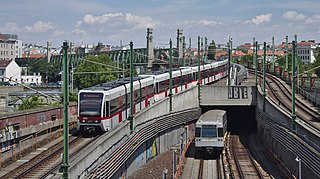
The Vienna U-Bahn, where U-Bahn is an abbreviation of the German word Untergrundbahn, is a rapid transit system serving Vienna, Austria. The five-line network consists of 83.1 kilometers (51.6 mi) of route, serving 109 stations. It is the backbone of what the International Association of Public Transport (UITP) deemed one of the best-performing public transport systems worldwide in 2009. 459.8 million passengers rode the U-Bahn in 2019. The network is undergoing expansion and rolling stock renewal. Since 1969, 200 million euros have been invested annually in the extension of the Vienna U-Bahn.

The Hamburg U-Bahn is a rapid transit system serving the cities of Hamburg, Norderstedt, and Ahrensburg in Germany. Although referred to by the term U-Bahn, most of the system's track length is above ground. The network is interconnected with the city's S-Bahn system, which also has underground sections. It is operated by Hamburger Hochbahn within the Hamburger Verkehrsverbund (HVV). It was opened in February 1912, and comprises four lines serving 93 stations, with a route length of 106.4 kilometres (66.1 mi) in 2019.

Hamburger Hochbahn AG (HHA), founded in 1911, operates the underground system and large parts of the bus system in Hamburg, Germany. Its name comes from the initial name given to the Hamburg metro system, Hochbahn.

Hamburg Hauptbahnhof, or Hamburg Central Railway Station in English, is the main railway station of the city of Hamburg, Germany. Opened in 1906 to replace four separate terminal stations, today Hamburg Hauptbahnhof is operated by DB Station&Service AG. With an average of 550,000 passengers a day, it is Germany's busiest railway station and the second-busiest in Europe after the Gare du Nord in Paris. It is classed by Deutsche Bahn as a category 1 railway station.

Landungsbrücken is a railway station and transport hub, located in Hamburg's St. Pauli quarter at the Landungsbrücken. It is part of the City S-Bahn line and the Hamburg U-Bahn.

Niendorf Nord is the western terminus station for the rapid transit trains of Hamburg U-Bahn line U2. The station is located in the Niendorf quarter of Hamburg, Germany.

Barmbek is a railway station and transport hub in Hamburg, Germany, for the underground railway (U-Bahn) system and the suburban railway (S-Bahn) system. The station is located in the district of Barmbek-Nord, Germany. Barmbek-Nord is part of the borough of Hamburg-Nord.

Falkenried was a former tram and metro carriage developer and manufacturer (1882–1965) as well as a bus developer based in Hamburg, Germany.
Transport in Hamburg comprises an extensive, rail system, subway system, airports and maritime services for the more than 1.8 million inhabitants of the city of Hamburg and 5.3 million people in the Hamburg Metropolitan Region.

The Type DT4 is a four-car electric multiple unit (EMU) train type operated by the Hamburger Hochbahn AG on the Hamburg U-Bahn system since 1988.

Kellinghusenstraße is a public transport railway station for the rapid transit trains of Hamburg U-Bahn lines U1 and U3 It is located in the Hamburg, Germany quarter of Eppendorf, in the borough of Hamburg-Nord.

The Type DT3 is a three-car electric multiple unit (EMU) train type operated by the Hamburger Hochbahn AG on the Hamburg U-Bahn.They were first introduced in 1968 to replace the 1911 to 1929-built Type T cars and to speed up the journey times on line U1.

The Type DT2 is a two-car electric multiple unit (EMU) train type operated by the Hamburger Hochbahn AG on the Hamburg U-Bahn until 2015. They replaced the Type T and Type TU.

The Type DT1 is a two-car electric multiple unit (EMU) train type operated by the Hamburger Hochbahn AG on the Hamburg U-Bahn until 1991. They were the first new U-Bahn trains since the 1920s.

Ohlstedt is the terminus station on the Ohlstedt branch of Hamburg U-Bahn line U1. The rapid transit station was opened in 1918 and is located in the Hamburg suburb of Wohldorf-Ohlstedt, Germany. Wohldorf-Ohlstedt is part of the Hamburg borough of Wandsbek.

Volksdorf is a rapid transit station on the Hamburg U-Bahn line U1. Volksdorf is the last station on the U1's main line, and branch-off station for the U1's Ohlstedt and Großhansdorf branches. The station is located in the Hamburg suburb of Volksdorf, Germany. Volksdorf is part of the Hamburg borough of Wandsbek.

is a quarter of Hamburg, Germany, in the borough of Hamburg-Nord. It is located in the east of Hamburg-Nord, approximately five kilometers from Hamburg city center. Barmbek-Süd is a densely built-up area.

Ochsenzoll is a station on the Hamburg U-Bahn line U1. Until 1969, it was the north western terminus of the line. It was opened in July 1921 and is located in Hamburg, Germany, in the quarter of Langenhorn. Langenhorn is part of the borough of Hamburg-Nord.

The Type DT5 is an electric multiple unit (EMU) train type operated by the Hamburger Hochbahn AG on the Hamburg U-Bahn system. It is the first type of rolling stock on the Hamburg U-Bahn that has air conditioning and gangways between the individual cars.
























